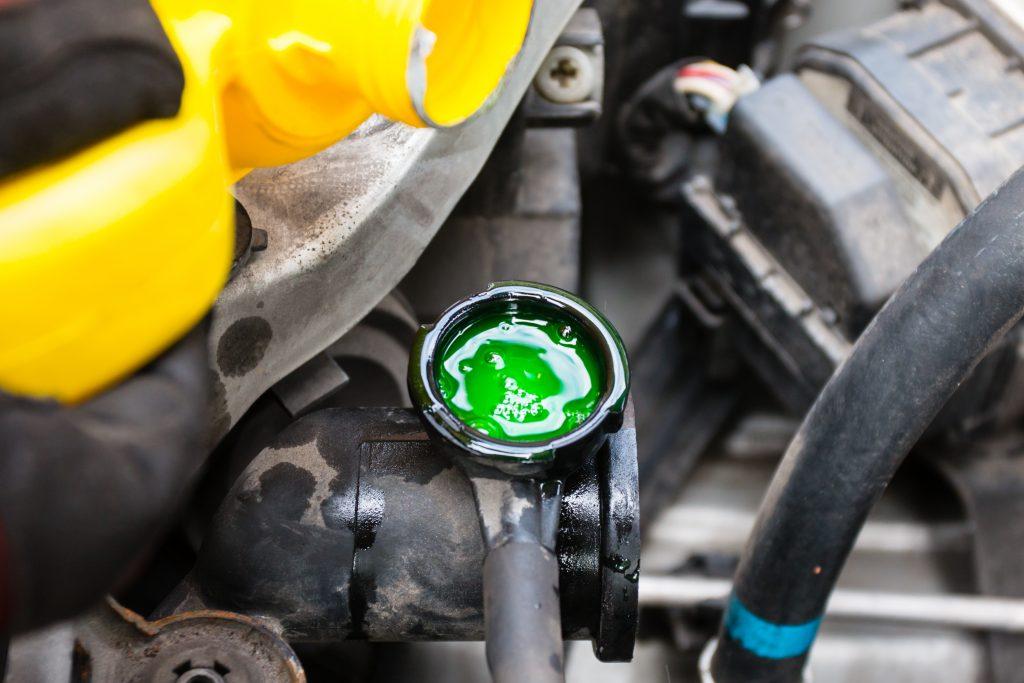Wondering why your engine coolant keeps disappearing? There could be several reasons.
Common causes include leaks, overheating, or internal engine problems. Engine coolant is crucial for your car’s health. It helps prevent the engine from overheating and maintains optimal performance. When coolant levels drop frequently, it signals a potential issue that requires attention.
Ignoring it can lead to severe engine damage. In this blog post, we will explore the various reasons behind disappearing engine coolant. Understanding these causes can help you diagnose and fix the problem before it escalates. Stay tuned to learn more about keeping your car running smoothly and avoiding costly repairs.
Common Causes Of Coolant Loss
Why does my engine coolant keep disappearing? This is a common question many car owners face. Losing coolant can lead to engine overheating and severe damage. Understanding the common causes of coolant loss can help you identify and fix the problem. Let’s explore some of the main reasons why your coolant might be disappearing.
Leaky Radiator
The radiator is essential for keeping your engine cool. A leak in the radiator can cause coolant to escape. Look for signs of puddles under your car. Also, check for any wet spots around the radiator. These are clear indicators of a leak. Radiator leaks often result from corrosion or physical damage. Regular maintenance can help you catch these issues early.
Blown Head Gasket
A blown head gasket is a serious issue. It can cause coolant to mix with engine oil. This is bad news for your engine. Signs of a blown head gasket include white smoke from the exhaust and a milky appearance in your oil. If you notice these signs, take your car to a mechanic immediately. Fixing a blown head gasket is crucial for your engine’s health.
Faulty Water Pump
The water pump circulates coolant through the engine. A faulty water pump can lead to coolant loss. Look for coolant leaks near the timing belt or the front of the engine. You might also hear a whining noise from the pump area. Replacing a faulty water pump is essential to prevent engine overheating.
| Cause | Signs | Solution |
|---|---|---|
| Leaky Radiator | Puddles under car, wet spots around radiator | Repair or replace radiator |
| Blown Head Gasket | White smoke, milky oil | Replace head gasket |
| Faulty Water Pump | Leaks near timing belt, whining noise | Replace water pump |

Credit: carfromjapan.com
Symptoms Of Coolant Leakage
Coolant leakage is a common issue many car owners face. Recognizing the symptoms of coolant leakage can help prevent serious engine damage. Below are some key signs to look out for.
Overheating Engine
An overheating engine is a clear sign. The engine may run hot and cause the temperature gauge to rise. This can lead to steam coming out from under the hood. If ignored, it can cause severe engine damage.
Visible Puddles
Look under your car for visible puddles. Coolant is usually green, orange, or pink. These puddles often form under the front of the car. They indicate a leak in the cooling system. Addressing this early can save you from expensive repairs.
Low Coolant Warning Light
The low coolant warning light on your dashboard is another sign. This light alerts you when the coolant level is low. It is crucial to check the coolant level and top it up if needed. Ignoring this warning can lead to an overheating engine.
Stay vigilant for these signs to maintain your car’s health. Regular checks can help you spot coolant leaks early.
Detecting Hidden Leaks
Sometimes, engine coolant vanishes without any visible signs. This can be frustrating. It is crucial to detect hidden leaks to prevent engine damage. Below are methods to find these sneaky leaks.
Pressure Testing
Pressure testing is a reliable method to find hidden coolant leaks. It involves using a special tool to pressurize the coolant system. This can reveal leaks that are not visible under normal conditions. Here is a simple guide:
- Start with a cool engine.
- Remove the radiator cap.
- Attach the pressure tester to the radiator neck.
- Pressurize the system to the recommended level.
- Inspect the system for leaks.
Check for drips or wet spots. These indicate a leak.
Using Uv Dye
UV dye is another effective tool to find hidden leaks. It involves adding a special dye to the coolant. The dye glows under UV light, making leaks easier to spot. Follow these steps:
- Add the UV dye to the coolant.
- Run the engine to circulate the dye.
- Turn off the engine and use a UV light to inspect.
Look for glowing spots. These reveal the leak’s location.
Coolant System Inspection
A thorough inspection of the coolant system can also uncover hidden leaks. Focus on these areas:
- Hoses and connections
- Radiator
- Water pump
- Heater core
- Head gasket
Check for any signs of moisture or corrosion. Pay attention to the smell of coolant, as it has a distinct sweet odor. This can help identify leaks in areas that are hard to see.
Regular inspections and maintenance can prevent coolant leaks. This ensures your engine runs smoothly and avoids overheating issues.
.png)
Credit: www.unitedtire.com
Internal Engine Problems
Engine coolant keeps your vehicle’s engine at the right temperature. If it keeps disappearing, internal engine problems might be the cause. These issues can be serious. They need quick attention to avoid further damage.
Cracked Engine Block
A cracked engine block can cause coolant to leak. This issue often happens due to extreme temperature changes. The crack can let coolant escape into places it shouldn’t be. This leads to lower coolant levels. You might also see white smoke from the exhaust. This is a sign the coolant is burning up.
Warped Cylinder Head
A warped cylinder head can also make coolant vanish. This part of the engine can bend or warp from overheating. When this happens, the seal between the cylinder head and the engine block breaks. This allows coolant to leak into the combustion chamber. You may notice your engine overheating. This is a clear sign of a warped cylinder head.
Intake Manifold Gasket Failure
The intake manifold gasket connects the intake manifold to the engine. If this gasket fails, it can let coolant leak out. This often happens in older vehicles or those with high mileage. A failing gasket can cause coolant to mix with engine oil. This mixture can damage your engine. Always check for any unusual fluid mixing.
Radiator And Hose Issues
Engine coolant disappearing can stem from several causes. Radiator and hose issues are common culprits. These components play a vital role in maintaining your engine’s temperature. Problems here can lead to coolant leaks or loss.
Corroded Radiator
A corroded radiator is a major issue. Over time, rust and mineral deposits can build up. This corrosion can create small holes and cracks. Coolant can leak through these holes. Regularly inspect your radiator for signs of rust. Replace it if you see significant corrosion.
Worn Out Hoses
Hoses transport coolant between engine parts. They can wear out over time. Cracks, splits, or bulges indicate wear. These worn-out hoses can leak coolant. Inspect your hoses regularly. Replace any that look damaged. This can prevent unexpected coolant loss.
Loose Hose Clamps
Hose clamps hold the hoses in place. They can become loose over time. Loose clamps can cause coolant to leak. Check the clamps during regular maintenance. Tighten any that are loose. This simple step can save you from bigger issues.
Preventative Maintenance Tips
Keeping your engine coolant in check is crucial for your vehicle’s health. Follow these preventative maintenance tips to ensure your coolant stays where it should be.
Regular Coolant Checks
Check your coolant levels every month. Look at the reservoir when the engine is cold. If the level is low, add more coolant. Also, inspect for any leaks or stains under the car. Early detection can prevent bigger problems.
Proper Coolant Mixture
Use the right mix of coolant and water. Typically, a 50/50 ratio works best. Check your car’s manual for the recommended ratio. Using the wrong mix can harm your engine. It can also lead to coolant loss.
Routine System Flush
Flush your coolant system every two years. This removes old coolant and any debris. Clean coolant helps your engine stay cool. It also prevents corrosion and blockages. Follow these steps for a routine flush:
- Let the engine cool completely.
- Drain the old coolant into a container.
- Flush the system with water.
- Refill with the proper coolant mixture.
Regular maintenance keeps your engine running smoothly. It also helps in detecting issues early. This saves you time and money in the long run.
Professional Repair Options
Experiencing a disappearing engine coolant can be frustrating. You may wonder what professional repair options are available. Let’s explore some of the best ways to address this issue.
Mechanic Inspection
A professional mechanic inspection is essential. Mechanics have the right tools and knowledge. They can identify leaks or problems that you may miss. This step ensures that you know the exact cause of coolant loss. Accurate diagnosis is the first step to effective repair.
Engine Repair
Sometimes, the problem is within the engine. Engine components like the head gasket may be damaged. Mechanics can repair or replace these parts. This repair can prevent future coolant loss. It can also improve overall engine performance.
Radiator Replacement
The radiator plays a key role in cooling. A damaged radiator can lead to coolant loss. If inspection shows radiator issues, replacement is necessary. New radiators can last longer and work better. They help maintain proper engine temperature.
Diy Fixes And Temporary Solutions
Engine coolant keeps your car from overheating. If it keeps disappearing, you need a fix. Sometimes a quick, temporary solution can save you time and money. Here are some DIY fixes that can help.
Using Stop Leak Products
Stop leak products can be found in auto parts stores. They can seal small leaks in your radiator or hoses. Pour the product into your coolant system. Follow the instructions on the package. This can be a temporary fix until you get a proper repair.
Replacing Worn Components
Check your coolant system for worn parts. Hoses and clamps can wear out over time. Replace any damaged parts with new ones. This can stop the coolant from leaking. Make sure to tighten all connections properly.
Sealant Application
Sealants can help fix minor leaks. Apply the sealant to the area where the leak is. Let it dry completely before adding new coolant. This can hold the leak temporarily. Always check the instructions on the sealant product.

Credit: www.reddit.com
Frequently Asked Questions
Why Is My Engine Coolant Disappearing?
Coolant might leak due to a cracked hose, radiator, or water pump.
How Do I Know If I Have A Coolant Leak?
Check for puddles under your car or a sweet smell inside.
Can A Faulty Radiator Cap Cause Coolant Loss?
Yes, a bad cap can let coolant escape as steam.
Is It Normal For Coolant Level To Drop Over Time?
No, significant drops often mean a leak or other issue.
Can Engine Overheating Cause Coolant To Disappear?
Yes, overheating can make coolant boil off or overflow.
Conclusion
Fixing disappearing engine coolant is crucial for your car’s health. Ignoring it can lead to bigger problems. Regular checks can help identify leaks early. Replace faulty parts promptly to avoid costly repairs. Consult a mechanic if you can’t find the issue.
Staying proactive keeps your engine running smoothly. Your vehicle will thank you. Take care of your car, and it will take care of you.

















